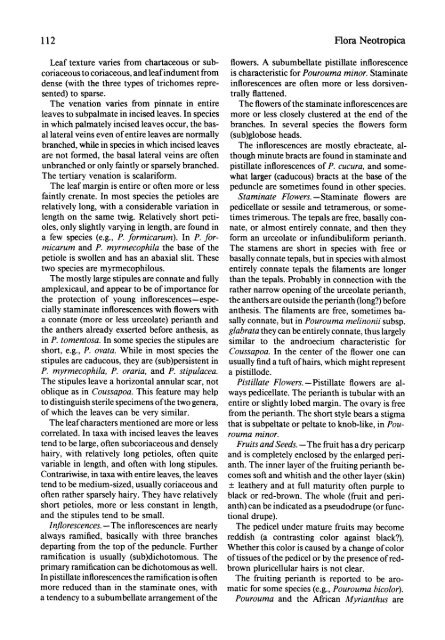Cecropiaceae: Coussapoa and Pourouma, with an ... - CNCFlora
Cecropiaceae: Coussapoa and Pourouma, with an ... - CNCFlora
Cecropiaceae: Coussapoa and Pourouma, with an ... - CNCFlora
Create successful ePaper yourself
Turn your PDF publications into a flip-book with our unique Google optimized e-Paper software.
112 Flora Neotropica<br />
Leaf texture varies from chartaceous or subcoriaceous<br />
to coriaceous, <strong><strong>an</strong>d</strong> leafindument from<br />
flowers. A subumbellate pistillate inflorescence<br />
is characteristic for <strong>Pourouma</strong> minor. Staminate<br />
dense (<strong>with</strong> the three types of trichomes repre- inflorescences are often more or less dorsivensented)<br />
to sparse.<br />
trally flattened.<br />
The venation varies from pinnate in entire The flowers of the staminate inflorescences are<br />
leaves to subpalmate in incised leaves. In species more or less closely clustered at the end of the<br />
in which palmately incised leaves occur, the bas- br<strong>an</strong>ches. In several species the flowers form<br />
al lateral veins even of entire leaves are normally (sub)globose heads.<br />
br<strong>an</strong>ched, while in species in which incised leaves The inflorescences are mostly ebracteate, alare<br />
not formed, the basal lateral veins are often though minute bracts are found in staminate <strong><strong>an</strong>d</strong><br />
unbr<strong>an</strong>ched or only faintly or sparsely br<strong>an</strong>ched. pistillate inflorescences of P. cucura, <strong><strong>an</strong>d</strong> some-<br />
The tertiary venation is scalariform.<br />
what larger (caducous) bracts at the base of the<br />
The leaf margin is entire or often more or less peduncle are sometimes found in other species.<br />
faintly crenate. In most species the petioles are Staminate Flowers. -Staminate flowers are<br />
relatively long, <strong>with</strong> a considerable variation in pedicellate or sessile <strong><strong>an</strong>d</strong> tetramerous, or somelength<br />
on the same twig. Relatively short peti- times trimerous. The tepals are free, basally conoles,<br />
only slightly varying in length, are found in nate, or almost entirely connate, <strong><strong>an</strong>d</strong> then they<br />
a few species (e.g., P. formicarum). In P. for- form <strong>an</strong> urceolate or infundibuliform peri<strong>an</strong>th.<br />
micarum <strong><strong>an</strong>d</strong> P. myrmecophila the base of the The stamens are short in species <strong>with</strong> free or<br />
petiole is swollen <strong><strong>an</strong>d</strong> has <strong>an</strong> abaxial slit. These basally connate tepals, but in species <strong>with</strong> almost<br />
two species are myrmecophilous.<br />
entirely connate tepals the filaments are longer<br />
The mostly large stipules are connate <strong><strong>an</strong>d</strong> fully th<strong>an</strong> the tepals. Probably in connection <strong>with</strong> the<br />
amplexicaul, <strong><strong>an</strong>d</strong> appear to be of import<strong>an</strong>ce for rather narrow opening of the urceolate peri<strong>an</strong>th,<br />
the protection of young inflorescences-espe- the <strong>an</strong>thers are outside the peri<strong>an</strong>th (long?) before<br />
cially staminate inflorescences <strong>with</strong> flowers <strong>with</strong> <strong>an</strong>thesis. The filaments are free, sometimes baa<br />
connate (more or less urceolate) peri<strong>an</strong>th <strong><strong>an</strong>d</strong> sally connate, but in <strong>Pourouma</strong> melinonii subsp.<br />
the <strong>an</strong>thers already exserted before <strong>an</strong>thesis, as glabrata they c<strong>an</strong> be entirely connate, thus largely<br />
in P. tomentosa. In some species the stipules are similar to the <strong><strong>an</strong>d</strong>roecium characteristic for<br />
short, e.g., P. ovata. While in most species the <strong>Coussapoa</strong>. In the center of the flower one c<strong>an</strong><br />
stipules are caducous, they are (sub)persistent in usually find a tuft of hairs, which might represent<br />
P. myrmecophila, P. oraria, <strong><strong>an</strong>d</strong> P. stipulacea. a pistillode.<br />
The stipules leave a horizontal <strong>an</strong>nular scar, not Pistillate Flowers. -Pistillate flowers are aloblique<br />
as in <strong>Coussapoa</strong>. This feature may help ways pedicellate. The peri<strong>an</strong>th is tubular <strong>with</strong> <strong>an</strong><br />
to distinguish sterile specimens of the two genera, entire or slightly lobed margin. The ovary is free<br />
of which the leaves c<strong>an</strong> be very similar. from the peri<strong>an</strong>th. The short style bears a stigma<br />
The leaf characters mentioned are more or less that is subpeltate or peltate to knob-like, in Poucorrelated.<br />
In taxa <strong>with</strong> incised leaves the leaves rouma minor.<br />
tend to be large, often subcoriaceous <strong><strong>an</strong>d</strong> densely Fruits <strong><strong>an</strong>d</strong> Seeds.- The fruit has a dry pericarp<br />
hairy, <strong>with</strong> relatively long petioles, often quite <strong><strong>an</strong>d</strong> is completely enclosed by the enlarged perivariable<br />
in length, <strong><strong>an</strong>d</strong> often <strong>with</strong> long stipules. <strong>an</strong>th. The inner layer of the fruiting peri<strong>an</strong>th be-<br />
Contrariwise, in taxa <strong>with</strong> entire leaves, the leaves comes soft <strong><strong>an</strong>d</strong> whitish <strong><strong>an</strong>d</strong> the other layer (skin)<br />
tend to be medium-sized, usually coriaceous <strong><strong>an</strong>d</strong> ? leathery <strong><strong>an</strong>d</strong> at full maturity often purple to<br />
often rather sparsely hairy. They have relatively black or red-brown. The whole (fruit <strong><strong>an</strong>d</strong> perishort<br />
petioles, more or less const<strong>an</strong>t in length, <strong>an</strong>th) c<strong>an</strong> be indicated as a pseudodrupe (or func<strong><strong>an</strong>d</strong><br />
the stipules tend to be small.<br />
tional drupe).<br />
Inflorescences. -The inflorescences are nearly The pedicel under mature fruits may become<br />
always ramified, basically <strong>with</strong> three br<strong>an</strong>ches reddish (a contrasting color against black?).<br />
departing from the top of the peduncle. Further Whether this color is caused by a ch<strong>an</strong>ge of color<br />
ramification is usually (sub)dichotomous. The of tissues of the pedicel or by the presence of redprimary<br />
ramification c<strong>an</strong> be dichotomous as well. brown pluricellular hairs is not clear.<br />
In pistillate inflorescences the ramification is often The fruiting peri<strong>an</strong>th is reported to be aromore<br />
reduced th<strong>an</strong> in the staminate ones, <strong>with</strong> matic for some species (e.g., <strong>Pourouma</strong> bicolor).<br />
a tendency to a subumbellate arr<strong>an</strong>gement of the <strong>Pourouma</strong> <strong><strong>an</strong>d</strong> the Afric<strong>an</strong> Myri<strong>an</strong>thus are
















